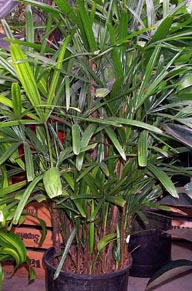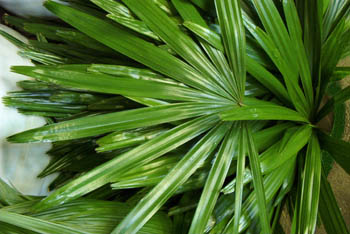|
Plants for your home
(By Mary Efanti)
Rhapis
 Description - Origin Description - Origin
Rhapis or commonly called Lady Palm, is one of the common plants we see mainly indoors but also in some
gardens.
It belongs to the palm family and is classified in two main varieties: the robust tropical plants that mainly originate in China and Taiwan and the smaller varieties that originate in Thailand and
Laos.
These plants have been cultivated as ornamentals as far back as the 17th
century. The upper social class in Japan started to cultivate
rhapis
plants in their homes since 1600 while the plants were introduced to Europe about 100 years
later. Rhapis has started to become more and more popular in the Western World around 1850.
Today, rhapis is cultivated throughout the world since it is very adaptable to different
climates, soils and environments. This is the main reason why rhapis has become such a popular indoor
plant. Other reasons are its ease of culture, its hardiness and its
longevity.
The leaves appear in groups on top of thin stems that remind canes. Their color is dark green while during summer you will notice tiny
cream-colored flowers among the leaves.
Care
Rhapis is an impressive plant with its height reaching approximately 1
meter. The plant grows sideways with shoots coming out from the ground next to the basic
branches. The shoots can increase in great numbers so the width of the plant may reach or exceed 1
meter.
The growth rate of rhapis is rather slow but vary depending on the variety and the
conditions. Obviously, it grows much faster if planted in the ground.
Usually, the plants for sale at the nurseries are about 2 years old. The larger plants may be as old as 7 years and this is why they are much more
expensive.
Rhapis is probably the easiest palm to grow indoors as long as you provide it with plenty of filtered
light. It can however slowly adapt to lower light conditions. Never let the plant get direct
sunlight, especially if this is coming through windows. The ideal temperature for this plant is between 16-29°C.
Rhapis is not freeze hardy, so if planted in the garden, protect it during extremely low
temperatures.
Remove the lower leaves when they start to age and fade. You can also carefully cut off the brown tips with a pair of
scissors. As rhapis is a slow grower, only remove what is really necessary to avoid stripping your
plant.
Rhapis is not demanding regarding soil quality as long as you provide excellent
drainage. It prefers light soils which allow the water to slowly soak all of the
soil. When you transplant, keep in mind that raphis needs to be root-bound so keep the pots
small. It also prefers its own pots so do not add other plants in the same
pot.
When you water, it is important to make sure all the soil gets wet. Do not let the soil dry out completely because the leaves will fade and dry out very
quickly. At the same time, make sure that the soil is not waterlogged because
rhapis is prone to root rot. Make sure to provide excellent drainage and do not let the pot sit in
water.
 Rhapis
is a slow grower so fertilizing cannot really speed up its development. If
however you think your plant needs some fertilizer, use half the dosage
mentioned on the instructions label. Rhapis
is a slow grower so fertilizing cannot really speed up its development. If
however you think your plant needs some fertilizer, use half the dosage
mentioned on the instructions label.
A good indicator of when to fertilize is the color of the leaves. Dark green
color shows that the plant is getting all the necessary nutrients. If the leaves
are fading and starting to yellow, it is possible that your plant needs more
minerals (contained in fertilizers for foliage plants) or iron deficiency. Brown
tips may also indicate that the water has too much chlorine. Especially for this
plant, try to use distilled water or rain water when watering. Brown tips also
indicate high temperature, lack of humidity or that the soil is not adequately
soaked during waterings
Insects and disease
Rhapis
is very prone to scale while it may also be attacked by spider mites. If you
notice such insects on your plant, take measures immediately because they can
damage your plant in no time. Spray the plant making sure that the underside of
the leaves is also covered since this is where these harmful insects are.
Propagation
Rhapis
plants, depending on the variety, can be propagated through seed or offshoots.
In order for the plant to produce seed the existence of both male and female
plants is necessary. In general, growing raphis from seeds is very demanding and
requires specialized care, you should prefer growing it from offshoots or buying
new developed plants.
Mary Efanti
[email protected]
|
